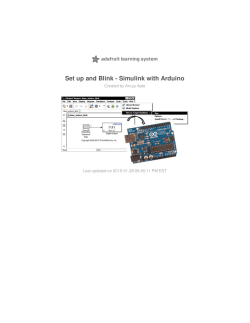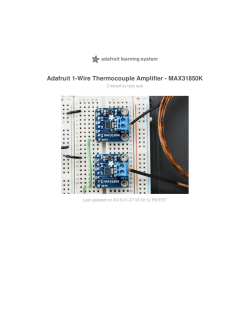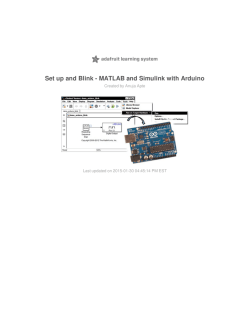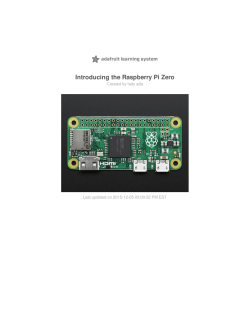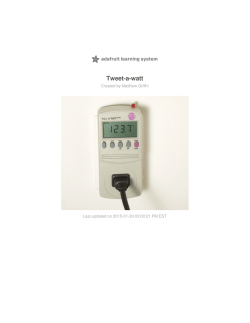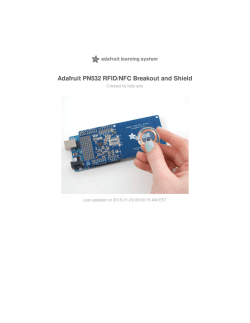
Download PDF - Adafruit Learning System
Adafruit DC and Stepper Motor HAT for Raspberry Pi
Created by lady ada
Last updated on 2015-02-03 05:30:10 PM EST
Guide Contents
Guide Contents
2
Overview
4
Assembly
9
Solder on Headers and Terminal Block
9
And Solder!
10
Powering Motors
17
Voltage requirements:
17
Current requirements:
17
Power it up
19
Installing Software
20
Enable I2C
20
Downloading the Code from Github
20
Using DC Motors
22
Connecting DC Motors
22
DC motor control walkthru
23
Creating the DC motor object
24
Setting DC Motor Speed
24
Setting DC Motor Direction
24
Using Stepper Motors
26
Connecting Stepper Motors
26
Stepper motor control walkthru
27
Creating the Stepper motor object
28
Stepping
28
step() - blocking steps
30
Using "Non-blocking" oneStep()
31
Stacking HATs
32
© Adafruit Industries
https://learn.adafruit.com/adafruit-dc-and-stepper-motor-hat-forraspberry-pi
Page 2 of 36
Addressing the HATs
33
Stacking in Code
34
Downloads
35
Motor ideas and tutorials
35
Datasheets
35
Schematic
35
Fabrication Print
35
© Adafruit Industries
https://learn.adafruit.com/adafruit-dc-and-stepper-motor-hat-forraspberry-pi
Page 3 of 36
Overview
Let your robotic dreams come true with the new DC+Stepper Motor HAT from Adafruit. This
Raspberry Pi add-on is perfect for any motion project as it can drive up to 4 DC or 2 Stepper
motors with full PWM speed control.
Raspberry Pi and mo to rs are no t included
© Adafruit Industries
https://learn.adafruit.com/adafruit-dc-and-stepper-motor-hat-forraspberry-pi
Page 4 of 36
Since the Raspberry Pi does not have a lot of PWM pins, we use a fully-dedicated PWM
driver chip onboard to both control motor direction and speed. This chip handles all the
motor and speed controls over I2C. Only two pins (SDA & SCL) are required to drive the
multiple motors, and since it's I2C you can also connect any other I2C devices or HATs to the
same pins.
In fact, yo u can even stack multiple Mo to r HATs, up to 32 of them, for controllung up
to 64 stepper motors or 128 DC motors - just remember to purchase and solder in a
stacking header instead of the one we include.
© Adafruit Industries
https://learn.adafruit.com/adafruit-dc-and-stepper-motor-hat-forraspberry-pi
Page 5 of 36
Motors are controlled TB6612 MOSFET driver: with 1.2A per channel and 3A peak
current capability, a big improvement over L293D drivers and there are built-in flyback
diodes as well.
© Adafruit Industries
https://learn.adafruit.com/adafruit-dc-and-stepper-motor-hat-forraspberry-pi
Page 6 of 36
We even had a little space so we added a polarity protection FET on the power pins and a bit
of prototyping area. And the HAT is assembled and tested here at Adafruit so all you have
to do is solder on the included 2x20 plain header and the terminal blocks.
Lets check out these specs again:
4 H-Bridges: TB6612 chipset provides 1.2A per bridge (3A peak) with thermal
shutdown protection, internal kickback protection diodes. Can run motors on 4.5VDC
to 13.5VDC.
Up to 4 bi-directio nal DC motors with individual 8-bit speed selection (so, about
0.5% resolution)
Up to 2 stepper mo to rs (unipolar or bipolar) with single coil, double coil,
interleaved or micro-stepping.
Big terminal block connectors to easily hook up wires (18-26AWG) and power
Polarity protected 2-pin terminal block and jumper to connect external 5-12VDC power
Works best with Raspberry Pi model B+ and A+, but can be used with a model A or B if
you purchase a 2x13 extra-tall header and solder that instead of the
2x20 (http://adafru.it/eib)
Install the easy-to-use Python library, check out the examples and you're ready to go!
© Adafruit Industries
https://learn.adafruit.com/adafruit-dc-and-stepper-motor-hat-forraspberry-pi
Page 7 of 36
Comes with an assembled & tested HAT, terminal blocks, and 2x20 plain header. Some
soldering is required to assemble the headers on. Stacking header not included, but we sell
them in the shop so if you want to stack HATs, please pick one up at the same time.
(http://adafru.it/2223)
Raspberry Pi and mo to rs are no t included but we have lots of motors in the shop
and all our DC motors, and stepper motors work great.
© Adafruit Industries
https://learn.adafruit.com/adafruit-dc-and-stepper-motor-hat-forraspberry-pi
Page 8 of 36
Assembly
Solder on Headers and Terminal Block
Before we can motorin' there's a little soldering to be done. This step will attach the 2x20
socket header so that we can plug this HAT into a Raspberry Pi, and the terminal blocks so
you can attach external power and motors.
Start by plugging the 2x20 header into a
Raspberry Pi, this will keep the header stable
while you solder. Make sure the Pi is powered
down!
Place the HAT on top so that the short pins of
the 2x20 header line up with the pads on the
HAT
© Adafruit Industries
https://learn.adafruit.com/adafruit-dc-and-stepper-motor-hat-forraspberry-pi
Page 9 of 36
And Solder!
Heat up your iron and solder in one header
connection on the right.
Once it is soldered, put down the solder and
reheat the solder point with your iron while
straightening the HAT so it isn't leaning down
(For tips on soldering, be sure to check out
our Guide to Excellent
Soldering (http://adafru.it/aTk)).
Solder one point on the opposite side of the
connector
© Adafruit Industries
https://learn.adafruit.com/adafruit-dc-and-stepper-motor-hat-forraspberry-pi
Page 10 of 36
Solder each of the connections for the top row
© Adafruit Industries
https://learn.adafruit.com/adafruit-dc-and-stepper-motor-hat-forraspberry-pi
Page 11 of 36
Flip the board around and solder all the
connections for the other half of the 2x20
header
© Adafruit Industries
https://learn.adafruit.com/adafruit-dc-and-stepper-motor-hat-forraspberry-pi
Page 12 of 36
Check over your work so far, make sure each
solder point is shiny, and isn't bridged or dull or
cracked
Now grab the 3.5mm-spaced terminal blocks.
These will let you quickly connect up your
motor and power supply using only a screw
driver
You will have 3 x 2-pin terminal blocks and 2 x
3-pin terminal blocks
Slide each of the 3-pin terminal blocks into a 2pin to create two 5-pin blocks
© Adafruit Industries
https://learn.adafruit.com/adafruit-dc-and-stepper-motor-hat-forraspberry-pi
Page 13 of 36
Slide the terminal blocks along the edge of the
HAT, so that the 'mouth' of each block is facing
out.
You can use scotch or other plain tape to keep
the terminal blocks flat against the PCB while
you solder
© Adafruit Industries
https://learn.adafruit.com/adafruit-dc-and-stepper-motor-hat-forraspberry-pi
Page 14 of 36
Flip over the board and solder in all of the
terminal block pins
© Adafruit Industries
https://learn.adafruit.com/adafruit-dc-and-stepper-motor-hat-forraspberry-pi
Page 15 of 36
Check over your work so far, make sure each
solder point is shiny, and isn't bridged or dull or
cracked
You're done! You can now move onto the
software side
© Adafruit Industries
https://learn.adafruit.com/adafruit-dc-and-stepper-motor-hat-forraspberry-pi
Page 16 of 36
Powering Motors
Motors need a lot of energy, especially cheap motors since they're less efficient.
Voltage requirements:
The first important thing to figure out what voltage the motor is going to use. If you're lucky
your motor came with some sort of specifications. Some small hobby motors are only
intended to run at 1.5V, but its just as common to have 6-12V motors. The motor controllers
on this HAT are designed to run from 5V to 12V.
MOST 1.5-3V MOTORS WILL NOT WORK or will be damaged by 5V power
Current requirements:
The second thing to figure out is how much current your motor will need. The motor driver
chips that come with the kit are designed to provide up to 1.2 A per motor, with 3A peak
current. Note that once you head towards 2A you'll probably want to put a heat-sink on the
motor driver, otherwise you will get thermal failure, possibly burning out the chip.
You can't run motors off of a 9V battery so don't waste your time/batteries!
Honestly, for portable we recommend you use a big Lead Acid or multiple-AA NiMH battery
pack - use 4 to 8 batteries to vary the voltage from about 6V to 12V as your motors require
© Adafruit Industries
https://learn.adafruit.com/adafruit-dc-and-stepper-motor-hat-forraspberry-pi
Page 17 of 36
If you don't have to take your project on the go, a 9V 1A (http://adafru.it/dO6), 12V
1A (http://adafru.it/eny), or 12V 5A w (http://adafru.it/enz)ill work nicely
99% o f 'weird mo to r pro blems' are due to having a voltage mismatch (too low a
voltage, too high a voltage) or not having a powerful enough supply! Even small DC motors
can draw up to 3 Amps when they stall.
© Adafruit Industries
https://learn.adafruit.com/adafruit-dc-and-stepper-motor-hat-forraspberry-pi
Page 18 of 36
Power it up
Wire up your battery pack to the Power terminal block on the right side of the HAT. It is
polarity protected but still its a good idea to check your wire polarity. Once the HAT has the
correct polarity, you'll see the green LED light up
Please no te the HAT do es no t po wer the Raspberry Pi, and we stro ngly
reco mmend having two seperate po wer supplies - one for the Pi and one for the
motors, as motors can put a lot of noise onto a power supply and it could cause stability
problems!
© Adafruit Industries
https://learn.adafruit.com/adafruit-dc-and-stepper-motor-hat-forraspberry-pi
Page 19 of 36
Installing Software
We have a Python library you can use to control DC and stepper motors, its probably the
easiest way to get started, and python has support for multithreading which can be really
handy when running multiple stepper motors at onces!
Enable I2C
You will have to make I2C support work on your Pi before you begin, visit our tutorial to
enable I2C in the kernel! (http://adafru.it/dZY)
Before you start, you'll need to have the python smbus library installed as well as 'git', run
apt-get install pytho n-smbus git
Downloading the Code from Github
The easiest way to get the code onto your Pi is to hook up an Ethernet cable or with a WiFi
setup, and clone it directly using 'git', which is installed by default on most distros.
Simply run the following commands from an appropriate location (ex. "/home/pi"):
git clone https://github.com/adafruit/Adafruit-Motor-HAT-Python-Library.git
cd Adafruit-Motor-HAT-Python-Library
Now install it with the setup install command:
sudo python setup.py install
© Adafruit Industries
https://learn.adafruit.com/adafruit-dc-and-stepper-motor-hat-forraspberry-pi
Page 20 of 36
That's it! Now you can get started with testing. Run
cd examples
from within the Motor HAT library folder, we have a couple examples to demonstrate the
different types of motors and configurations. The next few pages will explain them
© Adafruit Industries
https://learn.adafruit.com/adafruit-dc-and-stepper-motor-hat-forraspberry-pi
Page 21 of 36
Using DC Motors
DC motors are used for all sort of robotic projects.
The Motor HAT can drive up to 4 DC motors bi-directionally. That means they can be driven
forwards and backwards. The speed can also be varied at 0.5% increments using the highquality built in PWM. This means the speed is very smooth and won't vary!
Note that the H-bridge chip is not meant for driving continuous loads over 1.2A or motors
that peak over 3A, so this is for small motors. Check the datasheet for information about the
motor to verify its OK!
Connecting DC Motors
To connect a motor, simply solder two wires to the terminals and then connect them to
either the M1, M2, M3, or M4. If your motor is running 'backwards' from the way you like,
just swap the wires in the terminal block
For this demo, please connect it to M3
Now go into the Adafruit-Motor-HAT-Python/examples folder and run sudo pytho n
DCtest.py to watch your motor spin back and forth.
© Adafruit Industries
https://learn.adafruit.com/adafruit-dc-and-stepper-motor-hat-forraspberry-pi
Page 22 of 36
DC motor control walkthru
Here's a walkthru of the code which shows you everything the MotorHAT library can do and
how to do it.
Start with importing at least these libraries:
#!/usr/bin/python
from Adafruit_MotorHAT import Adafruit_MotorHAT, Adafruit_DCMotor
import time
import atexit
The MotorHAT library contains a few different classes, one is the MotorHAT class itself which
is the main PWM controller. You'll always need to create an object, and set the address. By
default the address is 0x60 (see the stacking HAT page on why you may want to change the
address)
© Adafruit Industries
https://learn.adafruit.com/adafruit-dc-and-stepper-motor-hat-forraspberry-pi
Page 23 of 36
# create a default object, no changes to I2C address or frequency
mh = Adafruit_MotorHAT(addr=0x61)
The PWM driver is 'free running' - that means that even if the python code or Pi linux kernel
crashes, the PWM driver will still continue to work. This is good because it lets the Pi focus on
linuxy things while the PWM driver does its PWMy things. But it means that the mo to rs
DO NOT STOP when the pytho n co de quits
Fo r that reaso n, we stro ngly reco mmend this 'at exit' co de when using DC
motors, it will do its best to shut down all the motors.
# recommended for auto-disabling motors on shutdown!
def turnOffMotors():
mh.getMotor(1).run(Adafruit_MotorHAT.RELEASE)
mh.getMotor(2).run(Adafruit_MotorHAT.RELEASE)
mh.getMotor(3).run(Adafruit_MotorHAT.RELEASE)
mh.getMotor(4).run(Adafruit_MotorHAT.RELEASE)
atexit.register(turnOffMotors)
Creating the DC motor object
OK now that you have the motor HAT object, note that each HAT can control up to 4 motors.
And you can have multiple HATs!
To create the actual DC motor object, you can request it from the MotorHAT object you
created above with getMo to r(num) with a value between 1 and 4, for the terminal number
that the motor is attached to
myMotor = mh.getMotor(3)
DC motors are simple beasts, you can basically only set the speed and direction.
Setting DC Motor Speed
To set the speed, call setSpeed(speed) where speed varies from 0 (off) to 255
(maximum!). This is the PWM duty cycle of the motor
# set the speed to start, from 0 (off) to 255 (max speed)
myMotor.setSpeed(150)
Setting DC Motor Direction
© Adafruit Industries
https://learn.adafruit.com/adafruit-dc-and-stepper-motor-hat-forraspberry-pi
Page 24 of 36
To set the direction, call run(direction) where direction is a constant from one of the
following:
Adafruit_Mo to rHAT.FORWARD - DC motor spins forward
Adafruit_Mo to rHAT.BACKWARD - DC motor spins forward
Adafruit_Mo to rHAT.RELEASE - DC motor is 'off', not spinning but will also not hold
its place.
while (True):
print "Forward! "
myMotor.run(Adafruit_MotorHAT.FORWARD)
print "\tSpeed up..."
for i in range(255):
myMotor.setSpeed(i)
time.sleep(0.01)
print "\tSlow down..."
for i in reversed(range(255)):
myMotor.setSpeed(i)
time.sleep(0.01)
print "Backward! "
myMotor.run(Adafruit_MotorHAT.BACKWARD)
print "\tSpeed up..."
for i in range(255):
myMotor.setSpeed(i)
time.sleep(0.01)
print "\tSlow down..."
for i in reversed(range(255)):
myMotor.setSpeed(i)
time.sleep(0.01)
print "Release"
myMotor.run(Adafruit_MotorHAT.RELEASE)
time.sleep(1.0)
© Adafruit Industries
https://learn.adafruit.com/adafruit-dc-and-stepper-motor-hat-forraspberry-pi
Page 25 of 36
Using Stepper Motors
Stepper motors are great for (semi-)precise control, perfect for many robot and CNC
projects. This HAT supports up to 2 stepper motors. The python library works identically for
bi-polar and uni-polar motors
Running a stepper is a little more intricate than running a DC motor but its still very easy
Connecting Stepper Motors
Fo r unipo lar mo to rs: to connect up the stepper, first figure out which pins connected to
which coil, and which pins are the center taps. If its a 5-wire motor then there will be 1 that is
the center tap for both coils. Theres plenty of tutorials online on how to reverse engineer the
coils pinout. (http://adafru.it/aOO) The center taps should both be connected together to the
GND terminal on the Motor HAT output block. then coil 1 should connect to one motor port
(say M1 or M3) and coil 2 should connect to the other motor port (M2 or M4).
Fo r bipo lar mo to rs: its just like unipolar motors except theres no 5th wire to connect to
ground. The code is exactly the same.
© Adafruit Industries
https://learn.adafruit.com/adafruit-dc-and-stepper-motor-hat-forraspberry-pi
Page 26 of 36
For this demo, please connect it to M1 and M2
Now go into the Adafruit-Motor-HAT-Python/examples folder and run sudo pytho n
StepperTest.py to watch your stepper motor spin back and forth.
Stepper motor control walkthru
Here's a walkthru of the code which shows you everything the MotorHAT library can do and
how to do it.
Start with importing at least these libraries:
#!/usr/bin/python
from Adafruit_MotorHAT import Adafruit_MotorHAT, Adafruit_DCMotor, Adafruit_StepperM$
import time
import atexit
The MotorHAT library contains a few different classes, one is the MotorHAT class itself which
is the main PWM controller. You'll always need to create an object, and set the address. By
default the address is 0x60 (see the stacking HAT page on why you may want to change the
address)
# create a default object, no changes to I2C address or frequency
mh = Adafruit_MotorHAT(addr = 0x60)
Even though this example code does not use DC motors, it's still important to note that the
PWM driver is 'free running' - that means that even if the python code or Pi linux kernel
crashes, the PWM driver will still continue to work. This is good because it lets the Pi focus on
linuxy things while the PWM driver does its PWMy things.
Stepper motors will not continue to move when the Python script quits, but it's still strongly
recommend that you keep this 'at exit' code, it will do its best to shut down all the motors:
# recommended for auto-disabling motors on shutdown!
def turnOffMotors():
mh.getMotor(1).run(Adafruit_MotorHAT.RELEASE)
mh.getMotor(2).run(Adafruit_MotorHAT.RELEASE)
mh.getMotor(3).run(Adafruit_MotorHAT.RELEASE)
mh.getMotor(4).run(Adafruit_MotorHAT.RELEASE)
atexit.register(turnOffMotors)
© Adafruit Industries
https://learn.adafruit.com/adafruit-dc-and-stepper-motor-hat-forraspberry-pi
Page 27 of 36
Creating the Stepper motor object
OK now that you have the motor HAT object, note that each HAT can control up to 2
steppers. And you can have multiple HATs!
To create the actual Stepper motor object, you can request it from the MotorHAT object you
created above with getStepper(steps, portnum) where steps is how many steps per
rotation for the stepper motor (usually some number between 35 - 200) ith a value between
1 and 2. Port #1 is M1 and M2, port #2 is M3 and M4
myStepper = mh.getStepper(200, 2)
# 200 steps/rev, motor port #1
Next, if you are planning to use the 'blocking' step() function to take multiple steps at once
you can set the speed in RPM. If you end up using oneStep() then this step isn't necessary.
Also, the speed is approximate as the Raspberry Pi can't do precision delays the way an
Arduino would. Anyways, we wanted to keep the Arduino and Pi versions of this library similar
so we kept setSpeed() in:
myStepper.setSpeed(30)
# 30 RPM
Stepping
Stepper motors differ from DC motors in that the controller (in this case, Raspberry Pi) must
tick each of the 4 coils in order to make the motor move. Each two 'ticks' is a step. By
alternating the coils, the stepper motor will spin all the way around. If the coils are fired in the
opposite order, it will spin the other way around.
If the python code or Pi crashes or stops responding, the motor will no longer move.
Compare this to a DC motor which has a constant voltage across a single coil for movement.
© Adafruit Industries
https://learn.adafruit.com/adafruit-dc-and-stepper-motor-hat-forraspberry-pi
Page 28 of 36
"StepperMotor" by Wapcaplet; Teravolt. (http://adafru.it/enC)
There are four essential types of steps you can use with your Motor HAT. All four kinds will
work with any unipolar or bipolar stepper motor
1. Single Steps - this is the simplest type of stepping, and uses the least power. It
uses a single coil to 'hold' the motor in place, as seen in the animated GIF above
2. Do uble Steps - this is also fairly simple, except instead of a single coil, it has two
coils on at once. For example, instead of just coil #1 on, you would have coil #1 and
#2 on at once. This uses more power (approx 2x) but is stronger than single stepping
(by maybe 25%)
3. Interleaved Steps - this is a mix of Single and Double stepping, where we use
single steps interleaved with double. It has a little more strength than single stepping,
and about 50% more power. What's nice about this style is that it makes your motor
appear to have 2x as many steps, for a smoother transition between steps
4. Micro stepping - this is where we use a mix of single stepping with PWM to slowly
transition between steps. It's slower than single stepping but has much higher
precision. We recommend 8 microstepping which multiplies the # of steps your
stepper motor has by 8.
while (True):
print("Single coil steps")
© Adafruit Industries
https://learn.adafruit.com/adafruit-dc-and-stepper-motor-hat-forraspberry-pi
Page 29 of 36
myStepper.step(100, Adafruit_MotorHAT.FORWARD, Adafruit_MotorHAT.SINGLE)
myStepper.step(100, Adafruit_MotorHAT.BACKWARD, Adafruit_MotorHAT.SINGLE)
print("Double coil steps")
myStepper.step(100, Adafruit_MotorHAT.FORWARD, Adafruit_MotorHAT.DOUBLE)
myStepper.step(100, Adafruit_MotorHAT.BACKWARD, Adafruit_MotorHAT.DOUBLE)
print("Interleaved coil steps")
myStepper.step(100, Adafruit_MotorHAT.FORWARD, Adafruit_MotorHAT.INTERLEAVE)
myStepper.step(100, Adafruit_MotorHAT.BACKWARD, Adafruit_MotorHAT.INTERLEAVE)
print("Microsteps")
myStepper.step(100, Adafruit_MotorHAT.FORWARD, Adafruit_MotorHAT.MICROSTEP)
myStepper.step(100, Adafruit_MotorHAT.BACKWARD, Adafruit_MotorHAT.MICROSTEP)
step() - blocking steps
As you can see above, you can step mulitple steps at a time with step()
step(numberofsteps, direction, type)
Where numbersteps is the number of steps to take, direction is either FORWARD or
BACKWARD and type is SINGLE, DOUBLE, INTERLEAVE or MICROSTEP
Note that INTERLEAVE will move half the distance of SINGLE or DOUBLE because there
are twice as many steps. And MICROSTEP will move 1/8 the distance because each
microstep counts as a step!
This is the easiest way to move your stepper but is blo cking - that means that the Python
program is completely busy moving the motor. If you have two motors and you call these
two procedures in a row:
stepper1.step(100, Adafruit_MotorHAT.FORWARD, Adafruit_MotorHAT.SINGLE)
stepper2.step(100, Adafruit_MotorHAT.BACKWARD, Adafruit_MotorHAT.SINGLE)
Then the first stepper will move 100 steps, stop, and then the second stepper will start
moving.
Chances are you'd like to have your motors moving at once!
For that, you'll need to take advantage of Python's ability to multitask with threads which you
can see in DualStepperTest.py
The key part of the DualStepperTest example code is that we define a function that will act
as a 'wrapper' for the step() procedure:
def stepper_worker(stepper, numsteps, direction, style):
© Adafruit Industries
https://learn.adafruit.com/adafruit-dc-and-stepper-motor-hat-forraspberry-pi
Page 30 of 36
#print("Steppin!")
stepper.step(numsteps, direction, style)
#print("Done")
We have some commented-out print statements in case you want to do some debugging.
Then, whenever you want to make the first stepper move, you can call:
st1 = threading.Thread(target=stepper_worker, args=(myStepper1, numsteps, direction, stepping_style
st1.start()
Which will spin up a background thread to move Stepper1 and will return immediately. You
can then do the same with the second stepper:
st2 = threading.Thread(target=stepper_worker, args=(myStepper2, numsteps, direction, stepping_style
st2.start()
You can tell when the stepper is done moving because the stepper thread you created will
'die' - test it with st2.isAlive() or st2.isAlive() - if you get True that means the stepper
is still moving.
Using "Non-blocking" oneStep()
OK lets say you want a lot of control over your steppers, you can use the one
oneStep(direction, stepstyle) which will make a single step in the style you request, with no
delay. This will let you step exactly when you like, for the most control
© Adafruit Industries
https://learn.adafruit.com/adafruit-dc-and-stepper-motor-hat-forraspberry-pi
Page 31 of 36
Stacking HATs
One of the cool things about this HAT design is that it is possible to stack them. Every HAT
you stack can control another 2 steppers or 4 DC motors (or a mix of the two)
You can stack up to 32 HAT for a total of 64 steppers or 128 DC motors! Most people will
probably just stack two or maybe three but hey, you never know. (PS if you drive 64
steppers from one Raspberry Pi send us a photo, OK?)
If you need to control a bunch of servos as well, you can use our 16-channel servo HAT and
stack it with this HAT to add a crazy large # of servos. (http://adafru.it/enA)
Stacking HATs is very easy. Each HAT you want to stack on top of must have stacking
headers installed. (http://adafru.it/2223) The top HAT does not have to have stacking
headers unless you eventually want to put something on top of it.
The only thing to watch for when stacking HATs is every HAT must have a unique I2C
address. The default address is 0x60. You can adjust the address of the motor HATs to
range from 0x60 to 0x80 for a total of 32 unique addresses.
© Adafruit Industries
https://learn.adafruit.com/adafruit-dc-and-stepper-motor-hat-forraspberry-pi
Page 32 of 36
Addressing the HATs
Each board in the stack must be assigned a unique address. This is done with the address
jumpers on the left side of the board. The I2C base address for each board is 0x60. The
binary address that you program with the address jumpers is added to the base I2C
address.
To program the address offset, use a drop of solder to bridge the corresponding address
jumper for each binary '1' in the address.
The bottom-most jumper is address bit #0, then the one above of that is address bit #1,
etc up to address bit #5
Board 0: Address = 0x60 Offset = binary 0000 (no jumpers required)
Board 1: Address = 0x61 Offset = binary 0001 (bridge A0)
Board 2: Address = 0x62 Offset = binary 0010 (bridge A1, the one above A0)
Board 3: Address = 0x63 Offset = binary 0011 (bridge A0 & A1, two bottom jumpers)
Board 4: Address = 0x64 Offset = binary 0100 (bridge A2, middle jumper)
© Adafruit Industries
https://learn.adafruit.com/adafruit-dc-and-stepper-motor-hat-forraspberry-pi
Page 33 of 36
etc.
Note that address 0x70 is the "all call" address for the controller chip on the HAT. All
boards will respond to address 0x70 - regardless of the address jumper settings.
Stacking in Code
We have an example in our Python library called StackingTest.py
The key part is to create two MotorHAT objects:
# bottom hat is default address 0x60
bottomhat = Adafruit_MotorHAT(addr=0x60)
# top hat has A0 jumper closed, so its address 0x61
tophat = Adafruit_MotorHAT(addr=0x61)
then use other of those for getting motors. We recommend using threading for control of
the steppers to make them turn together
© Adafruit Industries
https://learn.adafruit.com/adafruit-dc-and-stepper-motor-hat-forraspberry-pi
Page 34 of 36
Downloads
Motor ideas and tutorials
Wikipedia has tons of information (http://adafru.it/aOF) on steppers
Jones on stepper motor types (http://adafru.it/aOH)
Jason on reverse engineering the stepper wire pinouts (http://adafru.it/aOI)
Datasheets
PCA9685 PWM driver (http://adafru.it/emJ)
TB6612 Motor driver (http://adafru.it/emK)
Schematic
Click to embiggen
Fabrication Print
This is a 'HAT mechanical standard' compatible!
© Adafruit Industries
https://learn.adafruit.com/adafruit-dc-and-stepper-motor-hat-forraspberry-pi
Page 35 of 36
© Adafruit Industries
Last Updated: 2015-02-03 05:30:14 PM EST
Page 36 of 36
© Copyright 2025
